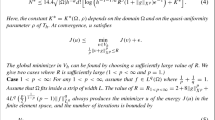Abstract
This paperFootnote 1 develops, with an eye on the numerical applications, an analogue of the classical Euler-Cauchy polygon method (which is used in the solution of the ordinary differential equation dy/dx=f(x, y), y(x 0)=y 0) for the solution of the following characteristic boundary value problem for a hyperbolic partial differential equation u xy =f(x, y, u, u x , y y ), u(x, y 0)=σ(x), u(x 0, y)=τ(y), where σ(x 0)=τ(y 0). The method presented here, which may be roughly described as a process of bilinear interpolation, has the advantage over previously proposed methods that only the tabulated values of the given functions σ(x) and τ(y) are required for its numerical application. Particular attention is devoted to the proof that a certain sequence of approximating functions, constructed in a specified way, actually converges to a solution of the boundary value problem under consideration. Known existence theorems are thus proved by a process which can actually be employed in numerical computation.
Similar content being viewed by others
Notes
This paper was issued on 16 January 1957 as NAVORD Report 4451, U. S. Naval Ordnance Laboratory, White Oak, Maryland, and was presented to the American Mathematical Society in October 1956.
References
Ascoli, G.: Le curve limite di una varietà data di curve. Memorie della Reale Accademia dei Lincei, Ser. 3 18, 521–586.
Peano, G.: Sur le théorème générale relatif à l'existence des intégrales des équations différentielles ordinaires. Nouvelles Annales de Mathématiques 11, 79–82 (1892).
Bianchi, L.: Applicazioni geometriche del metodo delle approssimazioni successive di Picard. Rendiconti della Reale Accademia dei Lincei, Ser. 5 3, 143–150 (1894).
Arzelà, C.: Sull'esistenza degli integrali nelle equazioni differenziali ordinarie. Memorie della Reale Accademia delle Scienze dell'Istituto di Bologna, Ser. 5 6, 131–140 (1896).
Picard, E.: Sur les méthodes d'approximations successives dans la théorie des équations différentielles. (Note I to vol. 4 of G. Darboux, Leçons sur la Théorie Générale des Surfaces, Paris, 1896, pp. 353–367.)
Fubini, G.: Alcuni nuovi problemi, che si presentono nella teoria delle equazioni alle derivate parziali. Atti della Reale Accademia di Torino 40, 616–631 (1905).
Arzelà, C.: Esistenza degli integrali nelle equazioni a derivate parziali. Memorie della Accademia delle Scienze dell'Istituto di Bologna, Ser. 6 3, 117–141 (1906).
Montel, P.: Sur les suites infinies de fonetions. Annales Scientifiques de l'École Normale Supérieure 24, 264–268 (1907).
Bliss, G. A.: Fundamental existence theorems. American Mathematical Society Colloquium Publications 3 (1913).
Gronwall, T. H.: Note on the derivatives with respect to a parameter of the solutions of a system of differential equations. Annals of Mathematics, Ser. 2 20, 292–296 (1919).
Tonelli, L.: Fondamenti di Calcolo delle Variazioni, vol. I. Bologna 1922.
Ince, E. L.: Ordinary Differential Equations. London 1927.
Tonelli, L.: Sulle equazioni integrali di Volterra, Memorie della Reale Accademia delle Scienze dell'Istituto di Bologna, Cl. Sci. Fis., Ser. 8 5, 59–64 (1927/28).
Lewy, H.: Über das Anfangswertproblem einer hyperbolischen nichtlinearen partiellen Differentialgleichung zweiter Ordnung mit zwei unabhängigen Veränderlichen. Math. Annalen 98, 179–190 (1928).
Tonelli, L.: Sulle equazioni funzionali del tipo di Volterra. Bulletin of the Calcutta Mathematical Society 20, 31–48 (1928).
Kamke, E.: Differentialgleichungen reeller Funktionen. Leipzig: Akademische Verlagsgesellschaft 1930.
Carathéodory, C.: Variationsrechnung und partielle Differentialgleichungen erster Ordnung. Berlin: B. G. Teubner 1935.
Brelot, M.: Les Principes Mathématiques de la Mécanique Classique. Paris: B. Arthaud 1945.
Giuliano, L.: Generalizzazione di un lemma de Gronwall e di una diseguaglianza di Peano. Rendiconti dell'Accademia Nazionale dei Lincei, Cl. Sci. Fis. Mat. Nat., Ser. 8 1, 1264–1271 (1946).
Faedo, S.: Su un teorema di esistenza di calcolo delle variazioni e una proposizione generale di calcolo funzionale. Annali della Scuola Normale Superiore di Pisa, Ser. 2 12, 119–133 (1947).
Sansone, G.: Equazioni Differenziali nel Campo Reale, Seconda edizione, Parte prima, 1948, Parte seconda, 1949; Bologna: N. Zanichelli.
Beckert, H.: Existenz- und Eindeutigkeitsbeweise für das Differenzenverfahren zur Lösung des Anfangswertproblems, des gemischten Anfangs-Randwert- und des charakteristischen Problems einer hyperbolischen Differentialgleichung zweiter Ordnung mit zwei unabhängigen Variablen. Ber. Verh. Sächs. Akad. Wiss. Leipzig, Math.-naturwiss. Kl. 97, 4 (1950).
Leehey, P.: On the existence of not necessarily unique solutions of classical hyperbolic boundary value problems for non-linear second order partial differential equations in two independent variables. Ph. D. thesis, Brown University, June 1950.
Zwirner, G.: Sull'approssimazione degli integrali del sistema differenziale ∂2z/∂x ∂y=f(x, y, z), z(x0, y) = ψ(y), z(x, y0)=φ(x). Atti dell'Istituto Veneto di Scienze, Lettere ed Arti, Cl. Sci. Fis. Mat. Nat. 109, 219–231 (1950/51).
Conti, R.: Sul problema iniziale per i sistemi di equazioni alle derivate parziali della forma z (i)x =f(i)(x, y; z(1), ... z(k); z (i)y ). Rendiconti dell' Accademia Nazionale dei Lincei, Cl. Sci. Fis. Mat. Nat., Ser. 8 12, Nota I, pp. 61–65, Nota II, pp. 151–155 (1952).
Hartman, P., & A. Wintner: On hyperbolic partial differential equations. Amer. Journal of Mathematics 74, 834–864 (1952).
Conti, R.: Sul problema di Darboux per l'equazione zxy=f (x, y, z, xx, zy). Annali dell'Università di Ferrara, Nouvo ser., Sez. 7, Sc. Mat. 2, 129–140 (1953).
Coddington, E. A., & N. Levinson: Theory of Ordinary Differential Equations. New York: McGraw-Hill 1955.
Moore, R. H.: Proof of an existence and uniqueness theorem of Picard for a non-linear hyperbolic partial differential equation, M. A. thesis, University of Maryland, June 1955.
Alexiewicz, A., & W. Orlicz: Some remarks on the existence and uniqueness of solutions of the hyperbolic equation ∂2z/∂x ∂y=f (x, y, z, ∂z/∂x, ∂z/∂y). Studia Mathematica 15, 201–215 (1956).
Author information
Authors and Affiliations
Additional information
Communicated by L. Cesari
Rights and permissions
About this article
Cite this article
Diaz, J.B. On an analogue of the Euler-Cauchy polygon method for the numerical solution of ux y = f(x, y, u, ux, uy). Arch. Rational Mech. Anal. 1, 357–390 (1957). https://doi.org/10.1007/BF00298015
Received:
Issue Date:
DOI: https://doi.org/10.1007/BF00298015



